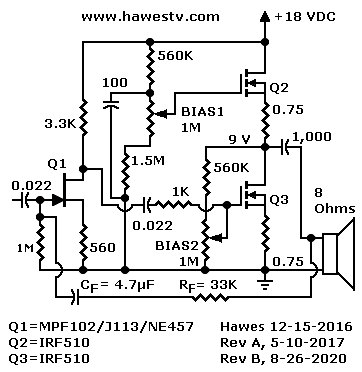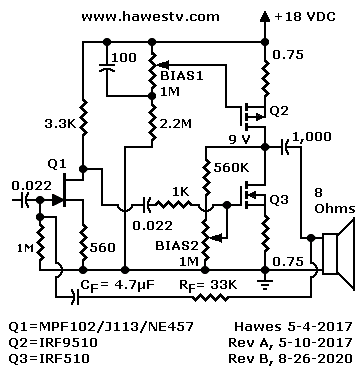|
Comparison to Zen Amp. Circuits similar to this one use a P-channel
MOSFET for the dynamic (active) load. See Nelson Pass' impeccable Zen
Amplifier circuit: An inspiration! Our IRF510 circuit is simpler
than the Zen, but retains the compliant current source idea. We use a
C-multiplier (Q2) instead of a zener multiplier.
Bibliography
Broskie, John. “Single-Ended.”
John Broskie's Guide to Tube Circuit Analysis & Design. May 18, 2014. 2016. Access on May 3, 2017.
https://www.tubecad.com/2014/05/blog0290.htm ▶Re: Discussion of compliant constant current source
for Zen Amplifier. Includes schematic. (Scroll quite far down, below cartoon of perplexed man.)
Houston, Mark. “DIY Class-A 2SK1058
MOSFET Amplifier.” DIY Audio Projects. April 3, 2012. Access on May 5, 2017.
http://diyaudioprojects.com/Solid/ZCA/ZCA.htm ▶Re: Single-ended MOSFET project without
active load. Requires 40-watt, 15-Ω load resistor. Schematic include amplifier circuit and 24-VDC
power supply for project. Excellent project photography. Links to other variations of project.
Loo, Heng Gin.
“Constant Current Source.” JK Audio Design. December 22, 2013. Access on May
11, 2017. http://jandkaudiodesign.blogspot.com/2013/12/constant-current-source.html ▶Re:
Advantages of constant current sources (and sinks) in sound amplifiers. Uses tube circuits
in examples: Includes CCS in preamp, SE power stage, and push-pull stage.
Meyer, Daniel.
“Reverb for Your Car.” Popular Electronics 25, no. 2 (1966), 50.
▶Re: The source of our optional feedback loop (CF / RF).
Pass, Nelson.
Amp Camp Amp #1 - diyAudio.” DIY Audio: Projects by Fanatics, for fanatics June 20, 2012.
Access on May 5, 2017. http://www.diyaudio.com/forums/diyaudio-com-articles/214808-amp-camp-amp-1-a.html
▶Re: Whole design process. 5W amp with enhancement MOSFETs.
Pass, Nelson. “Single-Ended Class
A.” Pass. September 1, 1998. 2016. Access on May 3, 2017.
https://www.tubecad.com/2014/05/blog0290.htm ▶Re: Single-ended, Class-A amplifiers using MOSFETs.
Pass, Nelson. “The SIT Nemesis
by Nelson Pass.” Firstwatt.com. n.m., n.d., 2011. Access on May 11, 2017.
http://www.firstwatt.com/pdf/art_sit_nemesis.pdf ▶Re: MOSFET, SE power amp with an output
transformer. Two versions: Version #1 uses depletion JFETs (SJDP120R085). (These self-bias like
triodes, unlike the enhancement MOSFETs that we used above.) Version #2 uses custom JFETs (Pass-SIT-1).
All these FETs come from the defunct SemiSouth foundry. The semiconductor material is silicon carbide
(SiC). The Version #2 JFET has characteristics that closely resemble those of a triode tube.
Pass, Nelson. “Zen
Amplifier.” Pass DIY. n.m., n.d., 2016. Access on May 3, 2017.
https://www.passdiy.com/gallery/amplifiers/the-zen-amplifier ▶Re: Original schematic and theory
of Zen Amplifier. Single-ended MOSFET design with zener multiplier (CCS) load.
SemiSouth.
“Normally On Trench Silicon Carbide Power JFET.” Rlocman.ru. May,
n.d., 2011. Access on May 11, 2017. http://www.rlocman.ru/i/File/dat/SemiSouth/JFETs/SJDP120R085.pdf
▶Re: Datasheet for the Type SJDP120R085 power JFET. This is one of the devices that
Nelson Pass uses in his SE amplifier designs. The manufacturer is SemiSouth Laboratories in Starkville,
MS. Unfortunately this semiconductor foundry is out of business as of 2017. Similar devices might
be available from other foundries. For example, Cree and Infineon.
Simon, Ed.
“A Solid State Single Ended Power Amp.” Audio Xpress.com. February 23, 2017.
Access on May 10, 2017. http://www.audioxpress.com/article/a-solid-state-single-ended-power-amp
•Re: Totem pole SE amplifier design: Discusses transistors vs. FETs, and includes project.
Project uses bipolar transistors. Includes power supply and heat sink design.
|


